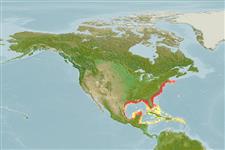Common names from other countries
Environment: milieu / climate zone / depth range / distribution range
Écologie
; profondeur 0 - 58 m (Ref. 83435). Tropical; 42°N - 16°N, 97°E - 70°E (Ref. 83435)
Distribution
Pays | Zones FAO | Écosystèmes | Occurrences | Introductions
Western Atlantic.
Length at first maturity / Taille / Poids / Âge
Maturity: Lm ? range ? - ? cm Max length : 8.2 cm DL mâle / non sexé; (Ref. 83435)
Found on offshore banks, on soft substrate (Ref. 109264).
Life cycle and mating behavior
Maturité | Reproduction | Frai | Œufs | Fécondité | Larves
Members of the order Neotaenioglossa are mostly gonochoric and broadcast spawners. Life cycle: Embryos develop into planktonic trocophore larvae and later into juvenile veligers before becoming fully grown adults.
Miloslavich, P., J.M. Díaz, E. Klein, J.J. Alvarado, C. Díaz, J. Gobin, E. Escobar-Briones, Motta, J.J. Cruz, E. Weil, J. Cortés, A.C. Bastidas, R. Roberston, F. Zapata, A. Martín, J. Castillo, A. Kazandjian and M. Ortiz. 2010. (Ref. 86671)
Statut dans la liste rouge de l'IUCN (Ref. 130435)
statut CITES (Ref. 108899)
Not Evaluated
Not Evaluated
Utilisations par l'homme
| FishSource |
Outils
Plus d'informations
Taille/Âge
Croissance
Longueur-poids
Longueur-longueur
Morphologie
Larves
Abondance
Sources Internet
Estimates based on models
Preferred temperature
(Ref.
115969): 11.8 - 25.9, mean 23.9 (based on 280 cells).
Catégorie de prix
Unknown.
